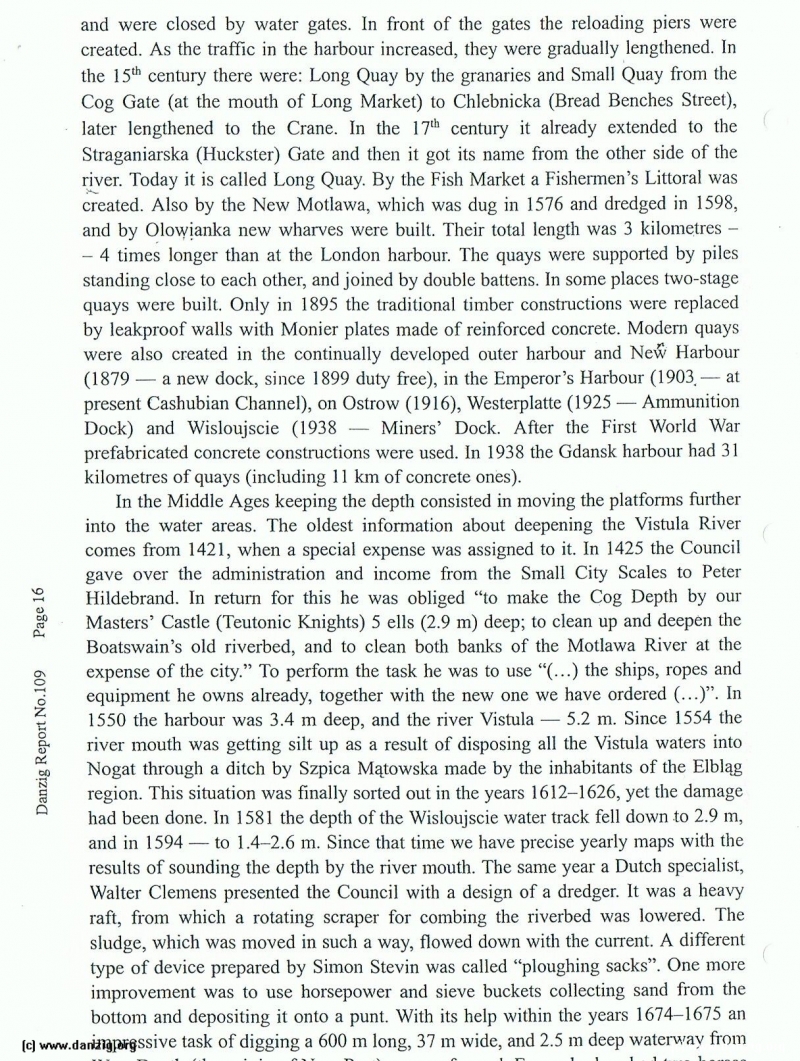
and were closed by water gates. In front of the gates the reloading piers were created. As the traffic in the harbour increased, they were gradually lengthened. In the 1 5th century there were: Long Quay by the granaries and Small Quay from the Cog Gate (at the mouth of Long Market) to Chlebnicka (Bread Benches Street), later lengthened to the Crane. In the 7 century it already extended to the Straganiarska (Huckster) Gate and then it got its name from the other side of the river. Today it is called Long Quay. By the Fish Market a Fishermen’s Littoral was created. Also by the New Motlawa, which was dug in 1576 and dredged in 1598, and by Olowianka new wharves were built. Their total length was 3 kilometres 4 times longer than at the London harbour. The quays were supported by piles standing close to each other, and joined by double battens. In some places two-stage quays were built. Only in 1895 the traditional timber constructions were replaced by leakproof walls with Monier plates made of reinforced concrete. Modern quays were also created in the continually developed outer harbour and Ne’’ Harbour (1879 — a new dock, since 1899 duty free), in the Emperor’s Harbour (1903.— at present Cashubian Channel), on Ostrow (1916), Westerplatte (1925 — Ammunition Dock) and Wisloujscie (1938 — Miners’ Dock. After the First World War prefabricated concrete constructions were used. In 1938 the Gdansk harbour had 31 kilornetres of quays (including 11 km of concrete ones).
In the Middle Ages keeping the depth consisted in moving the platforms further into the water areas. The oldest information about deepening the Vistula River comes from 1421, when a special expense was assigned to it. In 1425 the Council gave over the administration and income from the Small City Scales to Peter Hildebrand. In return for this he was obliged “to make the Cog Depth by our Masters’ Castle (Teutonic Knights) 5 ells (2.9 m) deep; to clean up and deepen the Boatswain’s old riverbed, and to clean both banks of the Motlawa River at the g expense of the city.” To perform the task he was to use “(...) the ships, ropes and equipment he owns already, together with the new one we have ordered (...)“. In 1550 the harbour was 3.4 m deep, and the river Vistula — 5.2 m. Since 1554 the river mouth was getting silt up as a result of disposing all the Vistula waters into Nogat through a ditch by Szpica M4towska made by the inhabitants of the Elbl4g region. This situation was finally sorted out in the years 16 12—1626, yet the damage had been done. In 1581 the depth of the Wisloujscie water track fell down to 2.9 m, and in 1594 — to 1.4—2.6 m. Since that time we have precise yearly maps with the results of sounding the depth by the river mouth. The same year a Dutch specialist, Walter Clemens presented the Council with a design of a dredger. It was a heavy raft, from which a rotating scraper for combing the riverbed was lowered. The sludge, which was moved in such a way, flowed down with the current. A different type of device prepared by Simon Stevin was called “ploughing sacks”. One more improvement was to use horsepower and sieve buckets collecting sand from the bottom and depositing it onto a punt. With its help within the years 1674—1675 an impressive task of digging a 600rn long, 37 rn wide, and 2.5 m deep waterway from
Danzig Report Vol. 1 - Nr. 109 - October - November - December - 2000, Page 22.
Hits: 3245
Added: 29/07/2015
Copyright: 2025 Danzig.org

